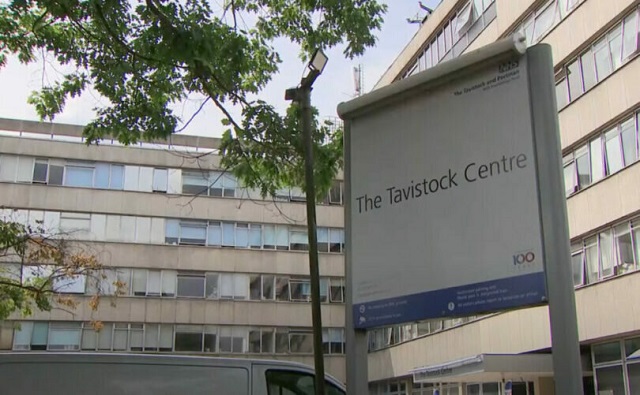Health
UK’s National Health Service to stop prescribing puberty blockers to gender-confused children

The UK’s Tavistock center
From LifeSiteNews
In January, it was revealed that the facility had seen almost 400 children younger than six years old and more than 70 aged four or younger over the past decade.
The British National Health Service (NHS) is formally ending the prescribing of puberty blockers to children with gender confusion, in a major policy shift representing a victory against transgender ideology.
The i Paper reports that the change follows the recommendation of a multi-year independent review led by consultant pediatrician Dr. Hilary Cass. The underage use of puberty blockers will now be limited to clinical research trials. The change does not apply to Scotland, whose government says blockers will only be considered for minors “after close psychological and endocrine assessment,” per the report.
“We have always been clear that children’s safety and wellbeing is paramount, so we welcome this landmark decision by the NHS,” said Health Minister Maria Caufield. “Ending the routine prescription of puberty blockers will help ensure that care is based on evidence, expert clinical opinion and is in the best interests of the child.”
Reconsideration of NHS’s standards for chemically “transitioning” young people was bolstered by years of concern over the lax standards at the scandal-ridden Gender Identity Development Service (GIDS), operated by the Tavistock and Portman NHS Foundation Trust. In January, it was revealed that the facility had seen almost 400 children younger than six years old and more than 70 aged four or younger over the past decade.
The GIDS had long been a source of controversy, from its backing of a discredited study used to justify giving puberty blockers to 11-year-olds, to a case last August in which it approved a “sex-change” procedure for a 22-year-old suffering from over a dozen mental health disorders.
Cass’s report found that the GIDS had failed to consistently collect follow-up data on the long-term outcomes for children who received puberty blockers, “which means it is not possible to accurately track the outcomes and pathways that children and young people take through the service.”
Puberty blockers, which are used to chemically castrate sex offenders, have been shown to devastate bone density in children, putting them at risk of osteoporosis, fractures, and other injuries. Other side effects associated with the drugs including emotional disorders, pseudotumor cerebri, paralysis, renal impairment, sudden cardiac death, and stroke in men, as LifeSiteNews has reported.
The Tavistock clinic is closing at the end of the month, and on Cass’s recommendation, NHS will be opening a pair of regional clinics in April, which it says will employ a more “holistic approach to care,” including neurodiversity, pediatrics, and mental health.
A significant body of evidence shows that “affirming” gender confusion carries serious harms, especially when done with impressionable children who lack the mental development, emotional maturity, and life experience to consider the long-term ramifications of the decisions being pushed on them, or full knowledge about the long-term effects of life-altering, physically transformative, and often irreversible surgical and chemical procedures.
Studies find that more than 80% of children experiencing gender dysphoria outgrow it on their own by late adolescence, and that even full “reassignment” surgery often fails to resolve gender-confused individuals’ heightened tendency to engage in self-harm and suicide — and may even exacerbate it, including by reinforcing their confusion and neglecting the actual root causes of their mental strife.
Some physicians heavily involved in transitioning minors have been caught on video admitting to more old-fashioned motives for such procedures, as with an exposé last year about Vanderbilt University Medical Center’s Clinic for Transgender Health in the United States, where Dr. Shayne Sebold Taylor said outright that “these surgeries make a lot of money.”
Health
Saskatchewan woman approved for euthanasia urged to seek medical help in Canada rather than US

From LifeSiteNews
Saskatchewan Premier Scott Moe encouraged Jolene Van Alstine, who has a rare disease, to work with his government on a solution.
Saskatchewan Premier Scott Moe is urging a woman with a rare disease, who has been approved to die by euthanasia because she can’t get proper care, to instead work with his government on a solution.
As reported by LifeSiteNews last week, Saskatchewan resident Jolene Van Alstine was approved to die by state-sanctioned euthanasia because she has had to endure long wait times for what she considers to be proper care for a rare parathyroid disease.
Van Alstine’s condition, normocalcemic primary hyperparathyroidism (nPHPT), causes her to experience vomiting, nausea, and bone pain.
As a result of Van Alstine’s frustrations with the healthcare system, she applied for Canada’s Medical Assistance in Dying (MAiD) and was approved for a January 7, 2026, death date.
Her case drew the attention of American media personality Glenn Beck, who has been in contact with Van Alstine to determine whether she can get the surgery done in the United States. Even the administration of U.S. President Donald Trump has been briefed on the matter.
According to Moe, Van Alstine has taken her case to Saskatchewan Health Minister Jeremy Cockrill, asking for help.
“There has been an opportunity to see specialists in Saskatchewan and outside of Saskatchewan, and those conversations about maybe potentially seeing additional specialists continue with the minister’s office and the Ministry of Health,” Moe said yesterday at a press conference.
“I would hope that she’d continue to work with the Ministry of Health, because I think there’s work going on to see even additional specialists at this point,”
A recent Euthanasia Prevention Coalition report revealed that Canada has euthanized 90,000 people since 2016, the year it was legalized.
Even some lobby groups have pushed for MAiD to be expanded to minors.
As reported by LifeSiteNews, over 23,000 Canadians have died while on wait lists for medical care as Prime Minister Mark Carney’s Liberal government focuses on euthanasia expansions.
Health
Canadian gov’t considers sharing census data on gender-confused children

From LifeSiteNews
Statistics Canada recently consulted LGBTQ+ groups on releasing 2021 census data about gender-confused children ages 0-14, citing research that toddlers could be ‘transgender.’
Statistics Canada is seeking to collect and share data on gender-confused children in its latest move to promote the LGBT agenda to minors.
From November to mid-December, Statistics Canada held consultations with various LGBT groups to discuss how to release 2021 census data on gender-confused children ages 0-14, according to a report shared with the National Post.
“For the upcoming 2026 Census, Statistics Canada has been consulting with the Canadian population, experts and stakeholders on gender,” the government agency wrote in a recent report.
“The Agency has finished conducting extensive qualitative and quantitative testing, notably to assess the impact of modifying the gender response categories to include ‘man’ and ‘woman,’ and ‘boy’ and ‘girl’ for those younger than 15 years,” it continued.
In 2021, StatsCan conducted the first-ever census to collect data on sex assigned at birth as well as how Canadians later ‘identified’ as their gender. The census collected data from Canadians of all ages but only published that of Canadians 15 years and older.
According to the information, released April 2022, 0.33% of the Canadian population age 15 or older were gender-confused, with 0.19% believing they are transgender and 0.14% believing they are non-binary.
The report noted that “younger generations may be more comfortable reporting their gender identity than older generations.”
Now, StatsCan is seeking to further push the LGBT agenda on young children by releasing data to support their argument that young children can be “transgender.”
According to a copy of its most recent report, “children and youth are often assumed to be cisgender (people whose reported gender corresponds to their birth sex) from birth until they ‘come out’ as a different gender on their own accord.”
“Researchers suggest that children aged 18 to 24 months are developmentally capable of recognizing gender norms and expressing gendered behaviours in visible ways,” it continued.
“Research also suggests that, like cisgender children, transgender and non-binary children may recognize their own gender identity as early as 2 to 3 years old or during later childhood or early adolescents,” the document read.
The StatsCan report conveniently ignores scientific data on the harms of gender-transitioning interventions, both on the physical and mental health of individuals, particularly children.
A significant body of evidence shows that “affirming” gender confusion carries serious harms, especially when done with impressionable children who lack the mental development, emotional maturity, and life experience to consider the long-term ramifications of the decisions being pushed on them, or full knowledge about the long-term effects of life-altering, physically transformative, and often irreversible surgical and chemical procedures.
Studies find that more than 80 percent of children suffering gender dysphoria outgrow it on their own by late adolescence and that “transition” procedures, including “reassignment” surgery, fail to resolve gender-confused individuals’ heightened tendency to engage in self-harm and suicide – and even exacerbate it, including by reinforcing their confusion and neglecting the actual root causes of their mental strife.
As LifeSiteNews has previously noted, research does not support the assertions from transgender activists that surgical or pharmaceutical intervention to “affirm” confusion is “necessary medical care” or that it is helpful in preventing the suicides of gender-confused individuals.
In fact, in addition to asserting a false reality that one’s sex can be changed, transgender surgeries and drugs have been linked to permanent physical and psychological damage, including cardiovascular diseases, loss of bone density, cancer, strokes and blood clots, infertility, and suicidality.
There is also overwhelming evidence that those who undergo “gender transitioning” are more likely to commit suicide than those who are not given irreversible surgery. A Swedish study found that those who underwent “gender reassignment” surgery ended up with a 19.2 times greater risk of suicide.
Indeed, there is proof that the most loving and helpful approach to people who think they are a different sex is not to validate them in their confusion but to show them the truth.
A new study on the side effects of transgender “sex change” surgeries discovered that 81 percent of those who had undergone “sex change” surgeries in the past five years reported experiencing pain simply from normal movement in the weeks and months that followed — and that many other side effects manifest as well.
-

 Business2 days ago
Business2 days agoMajor tax changes in 2026: Report
-

 Daily Caller1 day ago
Daily Caller1 day agoChinese Billionaire Tried To Build US-Born Baby Empire As Overseas Elites Turn To American Surrogates
-

 Digital ID1 day ago
Digital ID1 day agoCanada releases new digital ID app for personal documents despite privacy concerns
-

 Daily Caller1 day ago
Daily Caller1 day agoTwo states designate Muslim group as terrorist
-

 International1 day ago
International1 day agoRussia Now Open To Ukraine Joining EU, Officials Briefed On Peace Deal Say
-

 Censorship Industrial Complex1 day ago
Censorship Industrial Complex1 day agoDeath by a thousand clicks – government censorship of Canada’s internet
-

 Energy1 day ago
Energy1 day agoCanada’s sudden rediscovery of energy ambition has been greeted with a familiar charge: hypocrisy
-

 Alberta2 days ago
Alberta2 days agoSchools should go back to basics to mitigate effects of AI









